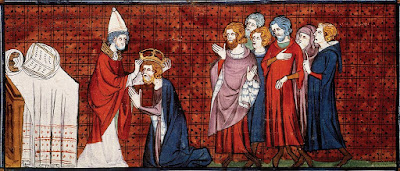| Pope Gregory at the Second Council of Lyons |
One of the items on the agenda was getting the two churches to agree to the same theology. The Filioque ["and the Son"] controversy was still an issue. The Greek text of the Nicene Creed was that the Holy Spirit proceeds "from the Father." The Roman view was that the Holy Spirit proceeds "from the Father and the Son." This divergence was firmly established in 325 by the first Nicene Council. The Greek delegation conceded to add the words "and the Son" to their version of the Creed. Sadly, Michael VIII's successor, Emperor Andronicus II (1259-1332), rejected the change.
The other East/West connection established at the Council was relations between Europe and the Mongol Empire of Abaqa Khan. A Crusade was planned, and the representatives of the Khan (one of whom went through a public baptism at Lyons) agreed to not hassle Christians during the war with Islam. Abaqa's father had once agreed to exempt Christians from taxes. Unfortunately, the Crusade never happened, and the grand gesture of cooperation did not take place.
So...improvements in East/West relations were attempted, but ultimately failed. The Council also was marred by other events. Thomas Aquinas wanted to attend, but died on the way. St. Bonaventure did attend, but died during the sessions..










